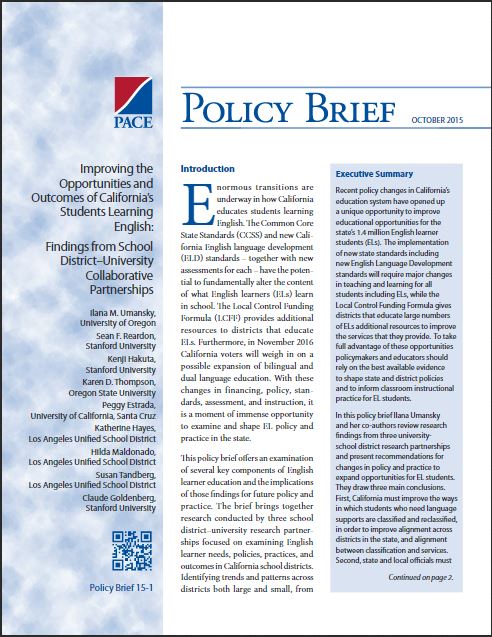By Karen Douglas, NCER Program Officer, English Learners
The education of English learners (EL) continues to be a topic of great interest across the country. But there has been little research to identify what steps to take in order to best serve this diverse group of students.
In recent years, the Institute of Education Sciences (IES) has funded a number of grants that are using data to better describe EL students and study the factors that are related to better educational outcomes. Findings from these studies are included in a recent policy brief by the Policy Analysis for California Education (PACE) entitled “Improving the Opportunities and Outcomes of California’s Students Learning English: Findings from School District-University Collaborative Partnerships.”

Although these studies all took place in California, the key findings likely have implications across the United States.
(Editor’s note: In some places you will see EL students referred to as English language learners (ELL), language minority, or limited English proficient (LEP) students. However, English learner (EL) is the term used by IES).
Defining ‘English Learner’
The term ‘English Learner’ seems pretty straightforward. It denotes a student that doesn’t speak English as a first language and whose lack of English skills serves as an impediment to learning. However, this simple term belies the diversity of this group of students.
Many EL students were born outside the U.S., but some are American citizens who were born in this country. Some arrive in the U.S. having gone to school starting at a very young age, while others come to the U.S. as teenagers and may not have had access to regular instruction in their previous country. And some EL students—such as the recent influx of unaccompanied minors from Central America—come from war-torn countries, where they have experienced significant trauma and have social emotional needs, as well.
Some EL students do not speak any English, but others come to our schools with basic English skills. And while a majority of ELs speak Spanish at home, many others speak European, African, and Asian languages.
Given all the ways that EL students differ from each other, there is a pressing need to move beyond the simple “EL” designation in order to better address the educational needs of these students.
You can learn more about the characteristics of EL students in a recent post to the National Center for Education Statistics (NCES) blog.
Meeting the Needs of EL Students
The context in which students designated as EL attend school is equally varied. Schools differ greatly in the criteria they use to identify students as ELs, as well as the rules for deciding that a student is no longer an EL.
In addition, some students attend schools at which the majority of students are ELs, whereas others are one of a handful of ELs in the school. Instructional programs, even among those that provide support for the home language, vary widely in regard to the amount of instruction in another language a student will receive and the manner in which it is integrated across content areas.
Leaving EL Status
The complexity of reclassification out of EL status is a central issue in the PACE brief because there is a concern that EL students may not have the same access to the full curriculum as their non-EL peers. The brief shares study findings in which EL students are overrepresented in lower-track classes, less likely to take important gateway math courses, and are more likely to be in classes with a higher percentage of ELs.
The studies in the PACE brief suggest that it is beneficial for students to be appropriately reclassified out of EL status, but these studies show that there is great variability in the stated criteria used by schools and districts as well as inconsistency in implementation. The report also highlights the potential benefits of bilingual and dual language programs both for learning in English as well as maintaining the first language.
Key Findings
The PACE policy brief makes three broad recommendations. Again, while these recommendations are directed at serving EL students in California, these are ideas that can be used throughout the country:

- Improve the ways in which students who need language supports are classified and reclassified in order to improve alignment across districts, and alignment between classification and services;
- Be more systematic in how data on EL students are collected and used, by tracking students’ progress over longer time periods and including all students who were ever EL students in accountability metrics; and
- Improve EL students’ educational opportunities in school by expanding access to core content, bilingual instruction, and well-prepared teachers.
Through better attention to the diverse characteristics of students designated as ELs, schools across the country will stand a better chance of both improving educational opportunities, as well as benefiting from the many contributions that EL students can provide to our school communities.